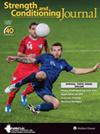A Scoping Review of the Physiological Profiles of Motorsport Drivers: Implications for Athlete Training
IF 3
4区 医学
Q2 SPORT SCIENCES
引用次数: 0
Abstract
ABSTRACT Automotive racing is one of the most internationally recognized sports. Drivers within their respective disciplines are exposed to a variety of forces throughout the race, each of which is theorized to inflict a physiological adaptation within the driver. Therefore, the aim of this scoping review was to collate the evidence and provide a summary of the physiological profiles of these drivers and provide practitioners with recommendations to optimize these adaptations. Of the 1,304 articles screened, 24 met the inclusion criteria. Of the included studies, 13 reported on the anthropometric and physiological measures of 4-wheeled racing athletes from both open and closed-wheel disciplines. The remaining 11 studies reported on the physiological profiles of 2-wheeled racing athletes from both on-road and off-road riding disciplines. Open-wheel racers have greater cardiopulmonary fitness than close-wheel racers, as well as greater strength throughout movements of neck lateral flexion and isometric knee extension. Close-wheel racers were shown to be heavier with greater fat mass than the open-wheel racers but exhibited greater isometric shoulder flexion and plantarflexion strength. Female 2-wheeled racers were also shown to have a weaker handgrip strength than their male counterparts. Whereas male on-road riders demonstrated greater levels of handgrip strength than their off-road counterparts.对赛车运动员生理特征的研究综述:对运动员训练的启示
赛车是最受国际认可的运动之一。在各自学科的车手在整个比赛中都要面对各种各样的力量,每一种力量都是理论上对车手的生理适应造成的。因此,本综述的目的是整理证据,总结这些驱动因素的生理特征,并为从业者提供优化这些适应的建议。在筛选的1304篇文章中,有24篇符合纳入标准。在纳入的研究中,13项报告了开放和封闭四轮赛车运动员的人体测量和生理测量。其余11项研究报告了公路和越野两轮赛车运动员的生理特征。开轮运动员比闭轮运动员有更好的心肺健康,在颈部侧屈和膝关节等距伸展运动中也有更大的力量。与开轮赛跑者相比,闭轮赛跑者体重更重,脂肪量更大,但表现出更大的等距肩屈和跖屈强度。女性两轮赛车手的握力也比男性车手弱。而男性公路车手的握力水平则高于越野车手。
本文章由计算机程序翻译,如有差异,请以英文原文为准。
求助全文
约1分钟内获得全文
求助全文
来源期刊

Strength and Conditioning Journal
社会科学-运动科学
CiteScore
4.70
自引率
8.00%
发文量
49
审稿时长
6-12 weeks
期刊介绍:
Strength and Conditioning Journal is the professional journal for strength coaches, personal trainers, physical therapists, athletic trainers, and other health professionals working in the strength and conditioning field. The journal’s mission is to publish articles that report both the practical applications of research findings and the knowledge gained by experienced professionals.
 求助内容:
求助内容: 应助结果提醒方式:
应助结果提醒方式:


